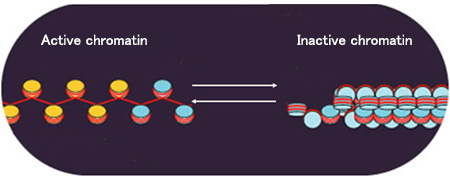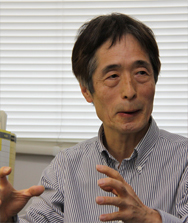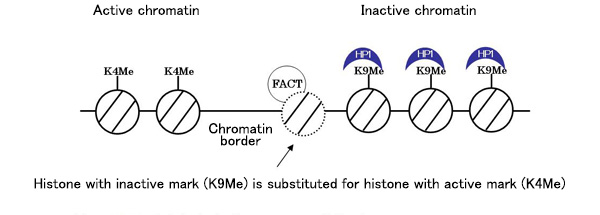HIROSE, Susumu – Professor Emeritus –

Base sequence is not the only factor that determines gene functions Dr. Hirose, a pioneer in a new branch of genetics
Dr. Hirose is one of the researchers who laid the foundations of a new branch of genetics called epigenetics. From the perspectives of genetics and molecular biology, he elucidated the mechanism underlying regulation of gene expression through structural changes in chromatin within the cell. Dr. Hirose worked at the NIG from 1986 to 2007 until his retirement. During this period, he served as the NIG’s Deputy Director. Today, he actively continues his research as Professor Emeritus. We asked him about his research life at the NIG.
Red-and-white eyed Drosophila (fruit flies)
Drosophila has the white gene that determines the color of its eyes. If this gene is activated, the fly gets red eyes, and if not activated, it gets white eyes. There are also fruit flies with variegated eyes (red-and-white eyed). In 1930, the American geneticist H. J. Muller (1890-1967) discovered that this is caused when the white gene in the chromosome is relocated near the inactive chromatin. “Variegation” means that the gene in question is activated in some parts and inactivated in others. I always wondered what mechanism governs this phenomenon.
My researches are focused on molecular biology. At the National Institute for Basic Biology, where I worked before coming to the NIG, I conducted research mainly on the chromatin structure and functions. In 1986, I arrived at the NIG. When I started genetic research here, I had the idea of working on the mystery of the variegated eyes of Drosophila. In the era of Muller, even the double helix structure of DNA was not yet known. In the 1980s, on the other hand, owing to progress in genetic engineering, the scientific community was gaining substantial knowledge about the genes related to variegation. So I decided to tackle this question both from the molecular biological and genetic standpoints.
White-eyed Drosophila
DNA is associated with the protein called histone to form chromatin in the chromosome. An extremely long strand of DNA can be neatly packed into the nucleus through folding of chromatin. Condensed chromatin inactivates DNA, while loosened chromatin activates DNA (Fig. 1). That is to say, the chromosome regulates DNA functions by modifying the chromatin structure.
Once the chromatin structure became clear, how Drosophila gets white eyes was also elucidated. When histones are methylated at a specific site (K9), HP1 proteins bind to the methylated histones, which in turn recruit the histone methylation enzyme to methylate nearby histones. In this manner, histone K9 methylation and HP1 binding continues and spreads, causing chromatin to condense and inactivating DNA. Then, the white gene is inactivated, resulting in white eyes. Conversely, red eyes means the gene is activated, but its mechanism was not clearly known.

Fig. 1 Chromatin structure
A set of 8 histones form a “beads-on-a-string” structure, with DNA (red thread) wrapped around them. Inactive chromatin is condensed while active chromatin is loosened.
Finally, the mechanism of red eyes was discovered

There is a border between active and inactive chromatin. We conducted our research while focusing on this chromatin border. Our research did not progress smoothly because the chromatin structure was quite complex and there was not sufficient information about it at first. We repeated various experiments day after day, and ten years later we discovered the protein FACT near the chromatin border. This discovery suddenly cleared up various mysteries, leading us to elucidate the mechanism in question.
When the FACT modifies the chromatin structure, the methylated histones with inactive mark (K9Me) are replaced by the histones with active mark (K4Me). These replaced histones form a sort of fortress to halt the spread of histone K9 methylation and HP1 binding. Then, the chromatin on the opposite side of the fortress becomes loose, allowing the gene to express (Fig. 2). This is how the colors red and white can both appear in the eyes. After 80 years from Muller’s discovery, the mystery was finally solved.
Epigenetics is a field that deals with any change in the function of genes due to a modification in the chromatin structure without a change in the base sequence carrying genetic information. We have learned that the base sequence is not the only factor that determines gene functions. We have also learned that epigenetics is involved not only in development and differentiation but also in cancer.

Fig. 2 Histone replacement at a chromatin border
Inactive chromatin tends to spread into the neighboring region. FACT-dependent histone replacement at the chromatin border prevents the spreading of inactive chromatin.
A nice collaboration of molecular biology and genetics
Since the time I began my research at the NIG, molecular biology of chromatin has rapidly progressed, and I have applied findings in that discipline to genetic research. In the Drosophila research, a nice collaboration of molecular biology and genetics helped us to understand many things. In the NIG’s research environment, we can thoroughly immerse ourselves in the studies we want to do, and hence, it was easy to try new things. I have managed to be at the frontline of research because I have been able to make research as I like. Although I was totally absorbed in my work, I also found the time for mountain climbing, which I love. These days, I only take leisurely walks in the fields and mountains, but communing with nature can sometimes result in unexpected insight.
Epigenetic researches are now actively conducted, and we are learning that epigenetics has an important role in behavior, learning and memory. I am particularly interested in memory. Memory has so far been understood only as phenomena, but I hope that its mechanism will be eventually elucidated from epigenetic approaches.
Message for young geneticists
Go forward toward your own research goals, thinking thoroughly until convincing yourselves. Don’t let people around you determine what to do, but just go on the way in which you believe.
(Interviewed by Narumi Sato/ Science Writer)
Back














